After traveling through much of wonderful Kyrgyzstan for two weeks, it was exciting to begin to discover Uzbekistan, the second of the 'stan' countries of the former Soviet Union we're visiting this trip. Uzbekistan - the land of the Uzbeks - is just the latest name used to describe the ancient lands between two rivers. The Greeks called the region Transoxiana; the Arabs knew it as Mawarannahr, the 'Land Across the River.' Uzbekistan's capital of Tashkent, known as Toshkent in Uzbek, our first of five cities we'd be seeing in the Central Asian republic, is the fourth largest city in the former USSR and the largest in Central Asia.
I read that the city grew up at the border of the settled and the nomadic worlds as Uzbekistan is two-thirds desert and one-third cotton. There'll be much more on the 'white gold' in future posts. The city's name was changed from Chach to Tashkent or Stone Village by the Turkic-speaking Karakhanids in the 10th century. In 1864, a Russian general captured the city disobeying direct orders from far off St. Petersburg. The city became the capital of the Uzbek SSR in 1930. The modern face of the city was transformed by the Soviet reconstruction that followed a powerful earthquake in 1966.
There was only one ATM in the Tashkent airport but unfortunately it had no money!
After being spoiled by recently having guesthouses or hotels in good location, our hotel in Tashkent was pretty far from the center and from restaurants. On the plus side, Anvar, the owner, was very friendly, spoke great English from having lived for years in the States and there was a metro stop about fifteen minutes' walk away. On the way to the metro, it was funny seeing a familiar place from home although this 7/11 was more a mini supermarket than a convenience store.
As soon as we stepped off the plane in Tashkent, we noticed the far greater military presence immediately. It was evident, we later realized, not only at the airport but throughout the city and indeed the whole country. No photos were allowed of the plane, for instance, as we walked toward the terminal. Before walking down the steps to any metro stops, there was always a police officer with a wand to theoretically inspect all bags, packages, backpacks and people. There was also another officer inside the station before going through the turnstiles and reaching the platforms. Often, there were also other officers on the platforms. We found, though, in the couple of dozen or more times we used the metro or the underpasses rarely were we 'wanded.' Whether it was because we obviously looked like foreigners or the police weren't at the top of their game, I don't know. Not growing up with such a strong military presence, I never did get used to the presence of the military throughout two weeks in Uzbekistan which we left just yesterday.
Just by what became 'our' metro stop was the National Central Bureau of Interpol, the first time we'd seen any Interpol building in any country.
The massive monument by the entrance to the metro was of Vladimira A. Dzhanibekova, a female cosmonaut.
One of the guidebooks I read talked about the 'stylish (metro) stations' in Tashkent and how it was worth riding the metro to see some of the stations that were 'dripping in decoration.' That was a far stretch from all the stations we saw as they were almost uniformly dim and dingy and not places I'd care ever to be alone in. Until very recently, no pictures were again allowed in the stations.
The station nearest the guesthouse was one of the more famous stations, Kosmonavtlar, with its floating cosmonauts that celebrated Soviet space achievements.
We never needed to wait more than five minutes anytime throughout the day for the subway. Plus, we couldn't beat the price of a ticket as each ride was only 2,100 Uzbek som, (as opposed to Kyrgyz som) which was only twelve cents, surely the cheapest ride anywhere in the world! There was no such thing as a metro card in Tashkent; you had to buy see-through blue plastic tokens from a cashier and then put it in the slot and walk through where a turnstile would normally have been.
As there were none any longer, an attendant watched to make sure you inserted the token! The trains were old hand-me downs from Moscow repainted in the bright colors of the Uzbek flag.
To get downtown, we had to switch lines at Navoi Station, a prettier station and with far better lighting.
Another of the stations we used a lot was Amir Timur, named after the merciless leader who conquered lands from India to Baghdad yet also was responsible for creating some of the world's most beautiful urban architecture the world has ever seen. Remember the name Timur, also known as Tamerlane, as he is known as Uzbekistan's favorite son and there will be plenty more about Timur in this and future posts!
Occupying a piece of prime real estate in central Tashkent was the extraordinary Soviet-modernist Hotel Uzbekistan. Across from it was the gigantic Amir Timur Maydoni or Square which we'd come to see. We just couldn't figure out how to get across the huge intersection so began exploring more of the buildings that surrounded the square.
Right next to the hotel was the stately Dom Forum that occasionally hosts state-sponsored events for honored guests. We didn't rate as it was closed when we we were there!
I wrote in several of the Kyrgyzstan posts about how friendly so many of the people were and how young people often came up to us to chat. We'd only been in the city center for a few minutes when that happened again! Several teenage boys, all immaculately dressed, began asking us questions about our impressions of Tashkent as part of their English studies. We had to tell them we'd only just arrived and couldn't help them.
Just off the square was the new and attractive City Hall. So much of Tashkent had beautiful new buildings after the city was rebuilt after the 1986 earthquake.
I saw a woman, not a city employee cleaning up, collecting acorns that were everywhere along the street. I wondered what she would do with all of them. Are they edible?
The front of City Hall through the bars of the gate:
An appealing clock tower:
Once we were further away from the Dom Forum, we were able to spot the pretty pelicans, or were they egrets or were they cranes atop the roof!
As I mentioned before, we had tried in vain to get Uzbek som at the ATM on arrival at the airport but without success. Anvar, the owner of our guesthouse, kindly loaned us some som until we could find an ATM. In most countries these days, you can find ATMs without too much difficulty especially in the capital city. Not in Tashkent! We finally found one, only to realize it just dispensed US dollars that would then have to be taken into the bank to exchange for som. That was of no help as we had greenbacks already!
We found a lovely pedestrian area and walked down it as it looked so pretty with its overhead lights and park.
At last, we came across a bank which had a working ATM. Steven got two million som, about $160! We had a tough time dealing with the money in Uzbekistan as there were about 8,000 som to the American dollar! Can you imagine how big your pockets need to be to carry around a wad of bills that large?! It was almost like dealing with Monopoly money as the bills seemed plat money.
The bank came along at the perfect time as there was a large crafts market taking place right by there! Vendors had come in for the weekend from from all over Uzbekistan to sell beautiful miniature paintings, gorgeous ikat-designed clothing, intricate wood-carved pieces and especially suzanis, embroidered and decorative textiles that Uzbekistan is famous for.
A throng of Japanese tourists gathered around the ikat-designed jackets that were so, so beautiful and very reasonable.
Friends in Denver who've been to our home know how we love to look at and occasionally buy small pieces of art when we travel overseas. This artist had some lovely work, one of which we ended up getting.
Normally in cities, we see the I 'heart' Paris signs, for example. The people of Tashkent did it differently by saying Tashkent 'heart' YOU! We'd also seen another one on the way in from the airport. Why do other cities not do the same, I wonder?
It was fun wandering down the adjacent Painters' Alley to see the local art and other items for sale. None of it was a patch on what had been available in the craft show but it was still fun to take a look.
These two young ladies wanted to interview us about what our experiences had been in Tashkent, what we liked about the city, etc but we had to explain we'd only arrived a few hours ago and didn't know enough about their city! There must have been a big push to welcome tourists as so many people came up to ask our impressions and to welcome us to Uzbekistan. It didn't feel the slightest bit fake, in my opinion, just a genuine warmth on the part of the people as had been the case in Kyrgyzstan.
Yet more paintings were for sale in front of a pretty gazebo. I saw no takers for any of those large works.
How fun to walk through these crazy-shaped hearts!
At the end of the park was the National Library.
Nearby was the Art Gallery of Uzbekistan but it was too late to see it then.
We walked over to the huge Soviet-era parade ground of Independence Square, the focus of celebrations each September 1 to mark the gaining of independence from the Soviet Union.
As we walked through another park toward another monument, it was so strange seeing the cutouts where either benches had been removed or where there had never been any. Never have we seen a city with so many parks with so few or no benches.
There was also an interesting stone mural behind the statue depicting scenes from the post-quake relief effort.
Another of the metro stations:
I read that the city grew up at the border of the settled and the nomadic worlds as Uzbekistan is two-thirds desert and one-third cotton. There'll be much more on the 'white gold' in future posts. The city's name was changed from Chach to Tashkent or Stone Village by the Turkic-speaking Karakhanids in the 10th century. In 1864, a Russian general captured the city disobeying direct orders from far off St. Petersburg. The city became the capital of the Uzbek SSR in 1930. The modern face of the city was transformed by the Soviet reconstruction that followed a powerful earthquake in 1966.
There was only one ATM in the Tashkent airport but unfortunately it had no money!
After being spoiled by recently having guesthouses or hotels in good location, our hotel in Tashkent was pretty far from the center and from restaurants. On the plus side, Anvar, the owner, was very friendly, spoke great English from having lived for years in the States and there was a metro stop about fifteen minutes' walk away. On the way to the metro, it was funny seeing a familiar place from home although this 7/11 was more a mini supermarket than a convenience store.
As soon as we stepped off the plane in Tashkent, we noticed the far greater military presence immediately. It was evident, we later realized, not only at the airport but throughout the city and indeed the whole country. No photos were allowed of the plane, for instance, as we walked toward the terminal. Before walking down the steps to any metro stops, there was always a police officer with a wand to theoretically inspect all bags, packages, backpacks and people. There was also another officer inside the station before going through the turnstiles and reaching the platforms. Often, there were also other officers on the platforms. We found, though, in the couple of dozen or more times we used the metro or the underpasses rarely were we 'wanded.' Whether it was because we obviously looked like foreigners or the police weren't at the top of their game, I don't know. Not growing up with such a strong military presence, I never did get used to the presence of the military throughout two weeks in Uzbekistan which we left just yesterday.
Just by what became 'our' metro stop was the National Central Bureau of Interpol, the first time we'd seen any Interpol building in any country.
The massive monument by the entrance to the metro was of Vladimira A. Dzhanibekova, a female cosmonaut.
The station nearest the guesthouse was one of the more famous stations, Kosmonavtlar, with its floating cosmonauts that celebrated Soviet space achievements.
We never needed to wait more than five minutes anytime throughout the day for the subway. Plus, we couldn't beat the price of a ticket as each ride was only 2,100 Uzbek som, (as opposed to Kyrgyz som) which was only twelve cents, surely the cheapest ride anywhere in the world! There was no such thing as a metro card in Tashkent; you had to buy see-through blue plastic tokens from a cashier and then put it in the slot and walk through where a turnstile would normally have been.
As there were none any longer, an attendant watched to make sure you inserted the token! The trains were old hand-me downs from Moscow repainted in the bright colors of the Uzbek flag.
To get downtown, we had to switch lines at Navoi Station, a prettier station and with far better lighting.
Another of the stations we used a lot was Amir Timur, named after the merciless leader who conquered lands from India to Baghdad yet also was responsible for creating some of the world's most beautiful urban architecture the world has ever seen. Remember the name Timur, also known as Tamerlane, as he is known as Uzbekistan's favorite son and there will be plenty more about Timur in this and future posts!
Occupying a piece of prime real estate in central Tashkent was the extraordinary Soviet-modernist Hotel Uzbekistan. Across from it was the gigantic Amir Timur Maydoni or Square which we'd come to see. We just couldn't figure out how to get across the huge intersection so began exploring more of the buildings that surrounded the square.
Right next to the hotel was the stately Dom Forum that occasionally hosts state-sponsored events for honored guests. We didn't rate as it was closed when we we were there!
I wrote in several of the Kyrgyzstan posts about how friendly so many of the people were and how young people often came up to us to chat. We'd only been in the city center for a few minutes when that happened again! Several teenage boys, all immaculately dressed, began asking us questions about our impressions of Tashkent as part of their English studies. We had to tell them we'd only just arrived and couldn't help them.
Just off the square was the new and attractive City Hall. So much of Tashkent had beautiful new buildings after the city was rebuilt after the 1986 earthquake.
I saw a woman, not a city employee cleaning up, collecting acorns that were everywhere along the street. I wondered what she would do with all of them. Are they edible?
The front of City Hall through the bars of the gate:
An appealing clock tower:
In the center of the nicely landscaped park was an imposing statue of Amir Timur gallantly riding a horse and waving to the presumably cheering masses. The gardens surrounding the statue were in excellent condition, beautifully maintained by women who swept the paths. I read that university students must do voluntary work one day a month to maintain the appearance of their city and that part of that entails weeding the gardens in the park.
Timur was a Mongol conqueror who was able to gain control over a large part of western, central and south Asia and the Middle East. He legitimized his conquest by 're-claiming' lands which had belonged to Genghis Khan. In the 14th century, Timur's empire, comprised 27 countries in the vast territory from the Mediterranean Sea to India. One of the guidebooks I read wrote "It has been estimated that his merciless campaigns led to the deaths of 17 million people. Prisoners in Isfizar in Iran were cemented alive into giant towers. His troops bombarded the Christian armies at Smyrna (now known as Izmir, Turkey) with cannonballs made with severed heads of their own knights. He boasted that his troops beheaded 10,000 Hindus in a single hour during the plunder of Delhi. In Baghdad in 1401, his forces killed 90,000 locals and cemented their heads into 120 towers."We found a lovely pedestrian area and walked down it as it looked so pretty with its overhead lights and park.
At last, we came across a bank which had a working ATM. Steven got two million som, about $160! We had a tough time dealing with the money in Uzbekistan as there were about 8,000 som to the American dollar! Can you imagine how big your pockets need to be to carry around a wad of bills that large?! It was almost like dealing with Monopoly money as the bills seemed plat money.
The bank came along at the perfect time as there was a large crafts market taking place right by there! Vendors had come in for the weekend from from all over Uzbekistan to sell beautiful miniature paintings, gorgeous ikat-designed clothing, intricate wood-carved pieces and especially suzanis, embroidered and decorative textiles that Uzbekistan is famous for.
A throng of Japanese tourists gathered around the ikat-designed jackets that were so, so beautiful and very reasonable.
Friends in Denver who've been to our home know how we love to look at and occasionally buy small pieces of art when we travel overseas. This artist had some lovely work, one of which we ended up getting.
Normally in cities, we see the I 'heart' Paris signs, for example. The people of Tashkent did it differently by saying Tashkent 'heart' YOU! We'd also seen another one on the way in from the airport. Why do other cities not do the same, I wonder?
It was fun wandering down the adjacent Painters' Alley to see the local art and other items for sale. None of it was a patch on what had been available in the craft show but it was still fun to take a look.
These two young ladies wanted to interview us about what our experiences had been in Tashkent, what we liked about the city, etc but we had to explain we'd only arrived a few hours ago and didn't know enough about their city! There must have been a big push to welcome tourists as so many people came up to ask our impressions and to welcome us to Uzbekistan. It didn't feel the slightest bit fake, in my opinion, just a genuine warmth on the part of the people as had been the case in Kyrgyzstan.
Yet more paintings were for sale in front of a pretty gazebo. I saw no takers for any of those large works.
How fun to walk through these crazy-shaped hearts!
The Concert Hall was just by the park with the craft fair and Painters' Alley.
The park was attractive but, as we later found out, not a place that encouraged people to sit and enjoy it as there were hardly any benches. For some reason, that was sadly the norm in Tashkent. Nearby was the Art Gallery of Uzbekistan but it was too late to see it then.
We walked over to the huge Soviet-era parade ground of Independence Square, the focus of celebrations each September 1 to mark the gaining of independence from the Soviet Union.
The Arch of Goodwill contained three 'dancing storks' intertwined over the central arch.
The pelicans on the arch apparently symbolized the tranquility of Uzbekistan!
The square had been home to the Soviet Union's largest Lenin statue until 1992 but that was replaced by a globe whose only country was an oversize Uzbekistan to suggest freedom! But when I tried to take a picture of it, about 20 guards appeared to shoo me away. Oops!
From the arches we thought we spotted the new Senate Building. It was only later that evening a guard told us it was a Business Center.
Again, there was really no place to sit down even among all the trees. It wasn't a place for children to play, just a place to walk through, take some pretty pictures, and then leave. It left me feeling cold, and a little bit sad for what could have been.
However, as we walked away from the arch (and the guards!), we came across the Eternal Flame and the Crying Mother Monument.
The statue of the weeping mother overlooking the martyr flame waiting for her warrior son to return home reminded me immediately of the similar one we had just seen in Bishkek, Kyrgyzstan. But this one had a far prettier and more serene setting. Never could we imagine wedding photos occurring here as this was a spot for solemn contemplation.
The statue was surrounded by two matching wooden memorials listing the names of 400,000 soldiers from Uzbekistan who died in WW II.
All war memorials are by their very nature sad, regardless of what side of the conflict you were 'for.' I found this one especially moving as we could turn the wooden pages listing those who had passed and read and touch their names so there was both a physical and visual connection.
Two blocks away was the Monument of Courage Earthquake Memorial which was built in 1976 to mark the 10th anniversary of a terrible earthquake that destroyed virtually the entire city and left 300,000 people homeless.
It was a typical Soviet-style memorial with huge figures defeating any adversity.
The memorial immortalized both the earthquake fissure and the time of the quake itself.There was also an interesting stone mural behind the statue depicting scenes from the post-quake relief effort.
From the somber to the amusing: more crazy angles to walk through!
How pretty Independence Square would look with places to sit and no guards shooing you away!
From a distance I was at last able to take a picture of the globe and the overly large Uzbekistan!
The Arch looked more enchanting at night.
Returning via metro to the guesthouse, it was funny seeing the ad for chicken weiners from Canada in the subway. I hated to think that's all that Uzbeks would know and think about my homeland!Another of the metro stations:
The planters changed colors at night!
Unlike so many other cities we've been lucky enough to visit, Tashkent was not a city that grabbed us, excited us and left us wanting to see far more. It didn't appear to be a city that knew how to put out the welcome mat for tourists - there were virtually no signs directing people to the city's attractions, no parks that invited people to sit and enjoy the surroundings, no explanations in English in the metro as is common worldwide, the presence of guards everywhere was off putting, and the fact there were only a few ATMs in the capital city was almost comical. What we were most struck by was we saw absolutely NO restaurants or fast food outlets, etc in about five hours of wandering a large swath of the city and the downtown core. We ended up having to buy some cheese and salami to have for dinner from a tiny grocery on the way back to the guesthouse as there was no other option!
On a positive note, however, many of the people went out of their way to be friendly to us, the monuments were striking, and the metro was cheap and a breeze to get around. Plus, this was just our first day and perhaps the next would be more positive.
Next post: Chorsu Bazaar, mosques & madrassas.
Posted on October 13th, 2018, from Shymkent, Kazakhstan, exactly two months since we left home. Where has that time gone?!










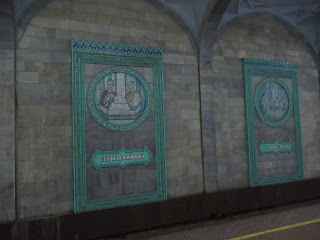








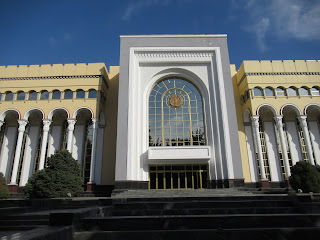

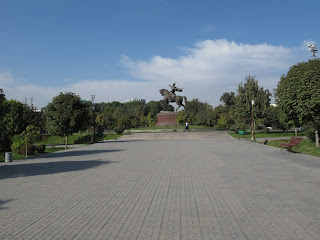








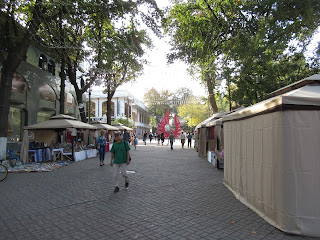

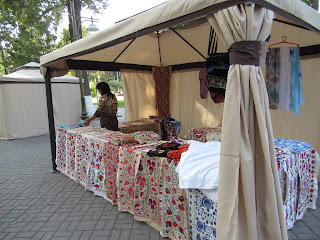
































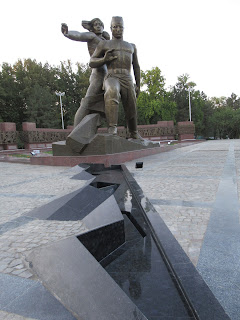












While your closing comments were not entirely positive re Tashkent, I was quite taken by the photos of the many beautiful buildings and metro stations in the capital.. I liked the diversity of the architecture and playfulness of the "arched" heart and angles. xoxo
ReplyDeleteTashkent was an anomaly, Lina, with some interesting and very attractive buildings and monuments, especially Independence Square, but also things that just didn't quite add up in the capital city like the almost total absence of benches to sit on in the city's parks and the appalling lack of restaurants. But so many people were exceedingly friendly, the metro system was cheap and easy to use, souvenirs were superb and reasonably priced and those factors helped to make up for a lot of the negatives.
ReplyDelete